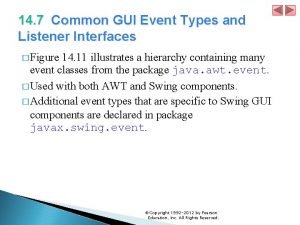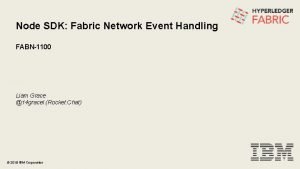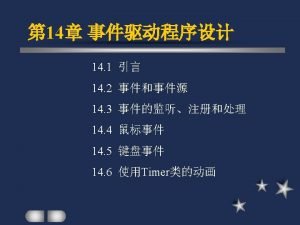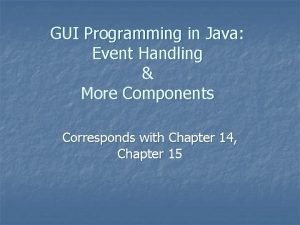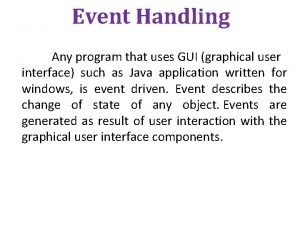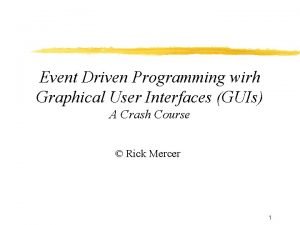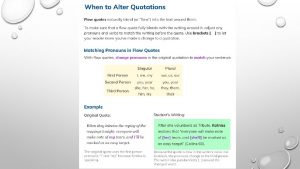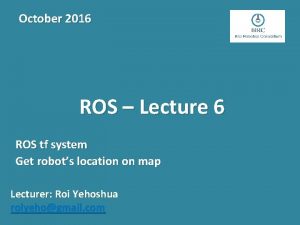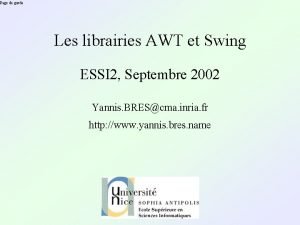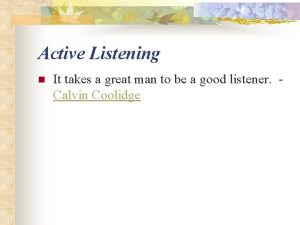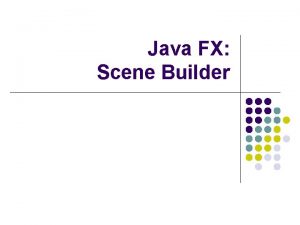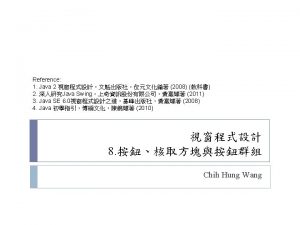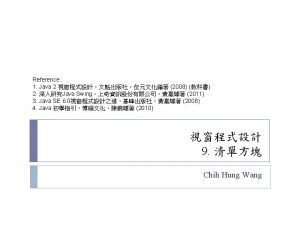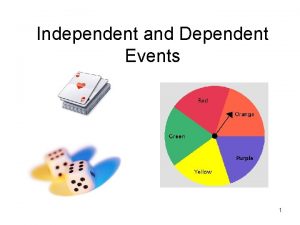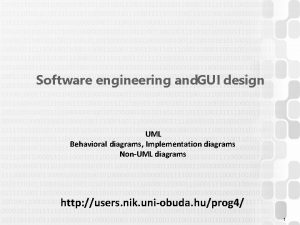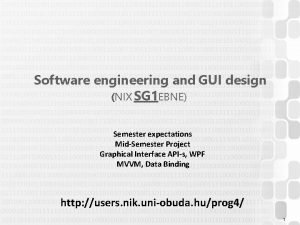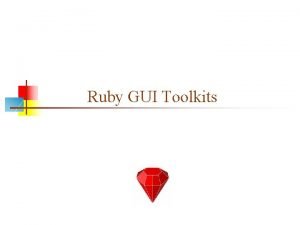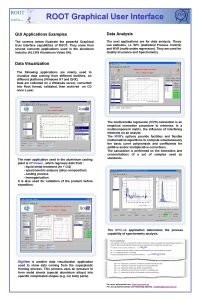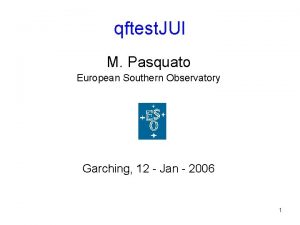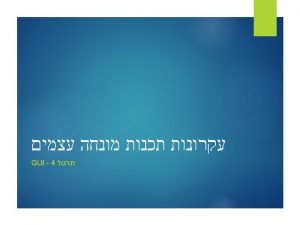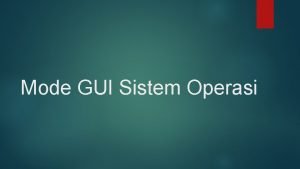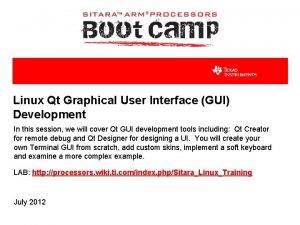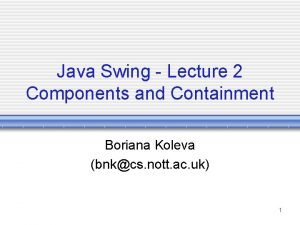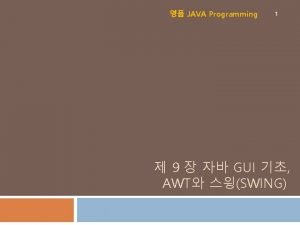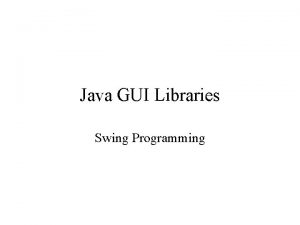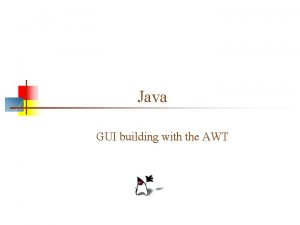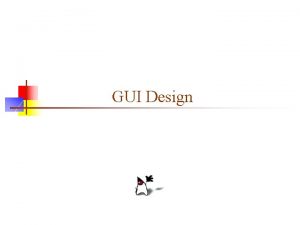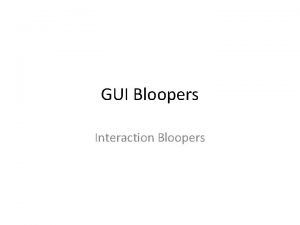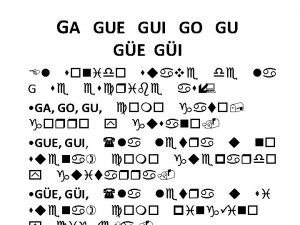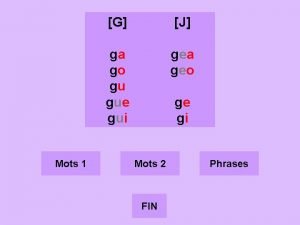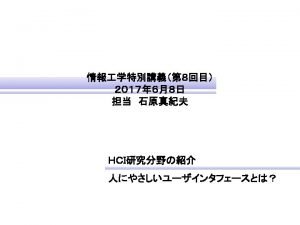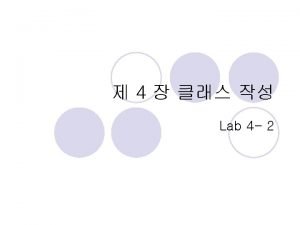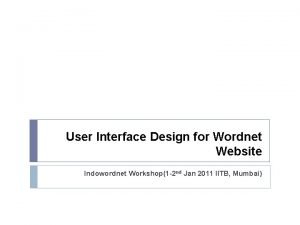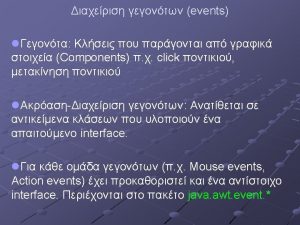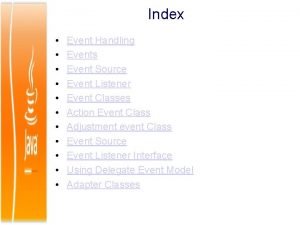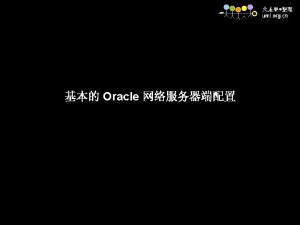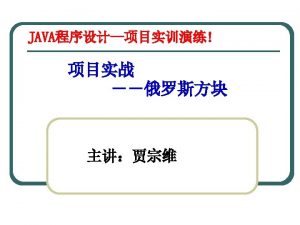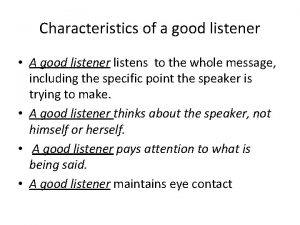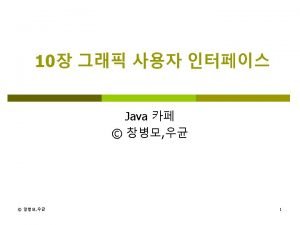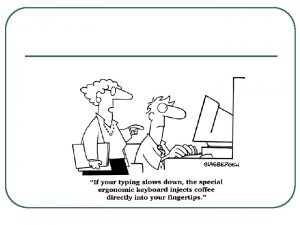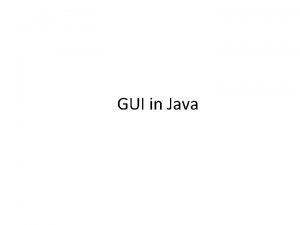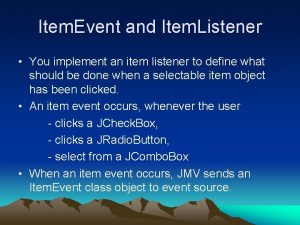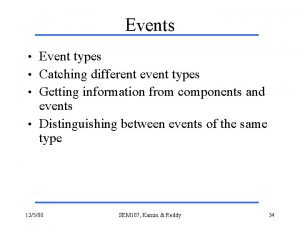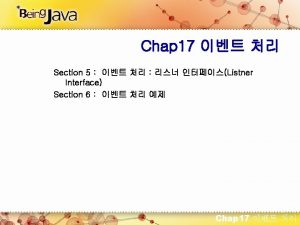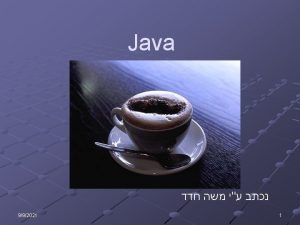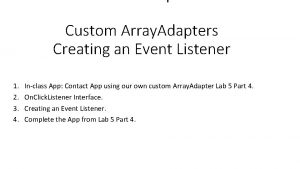14 7 Common GUI Event Types and Listener















































































- Slides: 79

14. 7 Common GUI Event Types and Listener Interfaces � Figure 14. 11 illustrates a hierarchy containing many event classes from the package java. awt. event. � Used with both AWT and Swing components. � Additional event types that are specific to Swing GUI components are declared in package javax. swing. event. © Copyright 1992 -2012 by Pearson Education, Inc. All Rights Reserved.


14. 7 Common GUI Event Types and Listener Interfaces (cont. ) � Delegation event model—an event’s processing is delegated to an object (the event listener) in the application. � For each event-object type, there is typically a corresponding event-listener interface. � Many event-listener types are common to both Swing and AWT components. ◦ Such types are declared in package java. awt. event, and some of them are shown in Fig. 14. 12. � Additional event-listener types that are specific to Swing components are declared in package javax. swing. event. © Copyright 1992 -2012 by Pearson Education, Inc. All Rights Reserved.


14. 7 Common GUI Event Types and Listener Interfaces (cont. ) � Each event-listener interface specifies one or more event-handling methods that must be declared in the class that implements the interface. � When an event occurs, the GUI component with which the user interacted notifies its registered listeners by calling each listener’s appropriate event-handling method. © Copyright 1992 -2012 by Pearson Education, Inc. All Rights Reserved.

14. 8 How Event Handling Works � How the event-handling mechanism works: � Every JComponent has a variable listener. List that refers to an Event. Listener. List (package javax. swing. event). � Maintains references to registered listeners in the listener. List. � When a listener is registered, a new entry is placed in the component’s listener. List. � Every entry also includes the listener’s type. © Copyright 1992 -2012 by Pearson Education, Inc. All Rights Reserved.


14. 8 How Event Handling Works (cont. ) � How does the GUI component know to call action. Performed rather than another method? ◦ Every GUI component supports several event types, including mouse events, key events and others. ◦ When an event occurs, the event is dispatched only to the event listeners of the appropriate type. ◦ Dispatching is simply the process by which the GUI component calls an event-handling method on each of its listeners that are registered for the event type that occurred. © Copyright 1992 -2012 by Pearson Education, Inc. All Rights Reserved.

14. 8 How Event Handling Works (cont. ) � Each event type has one or more corresponding event-listener interfaces. ◦ Action. Events are handled by Action. Listeners ◦ Mouse. Events are handled by Mouse. Listeners and Mouse. Motion. Listeners ◦ Key. Events are handled by Key. Listeners � When an event occurs, the GUI component receives (from the JVM) a unique event ID specifying the event type. ◦ The component uses the event ID to decide the listener type to which the event should be dispatched and to decide which method to call on each listener object. © Copyright 1992 -2012 by Pearson Education, Inc. All Rights Reserved.

14. 8 How Event Handling Works (cont. ) � For an Action. Event, the event is dispatched to every registered Action. Listener’s action. Performed method. � For a Mouse-Event, the event is dispatched to every registered Mouse. Listener or Mouse. Motion. Listener, depending on the mouse event that occurs. ◦ The Mouse. Event’s event ID determines which of the several mouse event-handling methods are called. © Copyright 1992 -2012 by Pearson Education, Inc. All Rights Reserved.

14. 9 JButton �A button is a component the user clicks to trigger a specific action. � Several types of buttons ◦ ◦ command buttons checkboxes toggle buttons radio buttons � Button types are subclasses of Abstract. Button (package javax. swing), which declares the common features of Swing buttons. © Copyright 1992 -2012 by Pearson Education, Inc. All Rights Reserved.



14. 9 JButton (cont. ) � A command button generates an Action. Event when the user clicks it. � Command buttons are created with class JButton. � The text on the face of a JButton is called a button label. © Copyright 1992 -2012 by Pearson Education, Inc. All Rights Reserved.






14. 9 JButton (cont. ) � A JButton can display an Icon. � A JButton can also have a rollover Icon ◦ displayed when the user positions the mouse over the JButton. ◦ The icon on the JButton changes as the mouse moves in and out of the JButton’s area on the screen. � Abstract. Button method set. Rollover. Icon specifies the image displayed on the JButton when the user positions the mouse over it. © Copyright 1992 -2012 by Pearson Education, Inc. All Rights Reserved.



14. 9 JButton (cont. ) � JButtons, like JText. Fields, generate Action. Events that can be processed by any Action. Listener object. © Copyright 1992 -2012 by Pearson Education, Inc. All Rights Reserved.


14. 10 Buttons That Maintain State � Three types of state buttons—JToggle. Button, JCheck. Box and JRadio. Button—that have on/off or true/false values. � Classes JCheck. Box and JRadio. Button are subclasses of JToggle. Button. � JRadio. Buttons are grouped together and are mutually exclusive—only one in the group can be selected at any time © Copyright 1992 -2012 by Pearson Education, Inc. All Rights Reserved.

14. 10. 1 JCheck. Box � � � JText. Field method set. Font (inherited by JText. Field indirectly from class Component) sets the font of the JText. Field to a new Font (package java. awt). String passed to the JCheck. Box constructor is the checkbox label that appears to the right of the JCheck. Box by default. When the user clicks a JCheck. Box, an Item. Event occurs. ◦ Handled by an Item. Listener object, which must implement method item. State. Changed. � � An Item. Listener is registered with method add. Item. Listener. JCheck. Box method is. Selected returns true if a JCheck. Box is selected. © Copyright 1992 -2012 by Pearson Education, Inc. All Rights Reserved.





14. 10. 2 JRadio. Button � Radio buttons (declared with class JRadio. Button) are similar to checkboxes in that they have two states—selected and not selected (also called deselected). � Radio buttons normally appear as a group in which only one button can be selected at a time. � Selecting a different radio button forces all others to be deselected. � Used to represent mutually exclusive options. � The logical relationship between radio buttons is maintained by a Button. Group object (package javax. swing), which organizes a group of buttons and is not itself displayed in a user interface. © Copyright 1992 -2012 by Pearson Education, Inc. All Rights Reserved.







14. 10. 2 JRadio. Button (cont. ) � Button. Group method add associates a JRadio. Button with the group. � If more than one selected JRadio. Button object is added to the group, the selected one that was added first will be selected when the GUI is displayed. � JRadio. Buttons, like JCheck. Boxes, generate Item. Events when they are clicked. © Copyright 1992 -2012 by Pearson Education, Inc. All Rights Reserved.

14. 11 JCombo. Box; Using an Anonymous Inner Class for Event Handling � A combo box (or drop-down list) enables the user to select one item from a list. � Combo boxes are implemented with class JCombo. Box, which extends class JComponent. � JCombo. Boxes generate Item. Events. © Copyright 1992 -2012 by Pearson Education, Inc. All Rights Reserved.






14. 11 JCombo. Box; Using an Anonymous Inner Class for Event Handling (cont. ) � The first item added to a JCombo. Box appears as the currently selected item when the JCombo. Box is displayed. � Other items are selected by clicking the JCombo. Box, then selecting an item from the list that appears. � JCombo. Box method set. Maximum. Row. Count sets the maximum number of elements that are displayed when the user clicks the JCombo. Box. � If there additional items, the JCombo. Box provides a scrollbar that allows the user to scroll through all the elements in the list. © Copyright 1992 -2012 by Pearson Education, Inc. All Rights Reserved.


14. 11 JCombo. Box; Using an Anonymous Inner Class for Event Handling (cont. ) � An anonymous inner class is an inner class that is declared without a name and typically appears inside a method declaration. � As with other inner classes, an anonymous inner class can access its top-level class’s members. � An anonymous inner class has limited access to the local variables of the method in which it’s declared. � Since an anonymous inner class has no name, one object of the anonymous inner class must be created at the point where the class is declared. © Copyright 1992 -2012 by Pearson Education, Inc. All Rights Reserved.


14. 11 JCombo. Box; Using an Anonymous Inner Class for Event Handling (cont. ) � JCombo. Box method get. Selected. Index returns the index of the selected item. � For each item selected from a JCombo. Box, another item is first deselected—so two Item. Events occur when an item is selected. � Item. Event method get. State. Change returns the type of state change. Item. Event. SELECTED indicates that an item was selected. © Copyright 1992 -2012 by Pearson Education, Inc. All Rights Reserved.


14. 12 JList � A list displays a series of items from which the user may select one or more items. � Lists are created with cla. JList, which directly extends class JComponent. ss � Supports single-selection lists (only one item to be selected at a time) and multiple-selection lists (any number of items to be selected). � JLists generate List. Selection. Events in singleselection lists. © Copyright 1992 -2012 by Pearson Education, Inc. All Rights Reserved.





14. 12 JList (cont. ) � set. Visible. Row. Count specifies the number of items visible in the list. � set. Selection. Mode specifies the list’s selection mode. � Class List. Selection. Model (of package javax. swing) declares selection-mode constants ◦ SINGLE_SELECTION (only one item to be selected at a time) ◦ SINGLE_INTERVAL_SELECTION (allows selection of several contiguous items) ◦ MULTIPLE_INTERVAL_SELECTION (does not restrict the items that can be selected). © Copyright 1992 -2012 by Pearson Education, Inc. All Rights Reserved.

14. 12 JList (cont. ) � Unlike a JCombo. Box, a JList does not provide a scrollbar if there are more items in the list than the number of visible rows. ◦ A JScroll. Pane object is used to provide the scrolling capability. � add. List. Selection. Listener registers a List. Selection. Listener (package javax. swing. event) as the listener for a. JList’s selection events. © Copyright 1992 -2012 by Pearson Education, Inc. All Rights Reserved.

14. 12 JList (cont. ) � � � � Each JFrame actually consists of three layers—the background, the content pane and the glass pane. The content pane appears in front of the background and is where the GUI components in the JFrame are displayed. The glass pane is displays tool tips and other items that should appear in front of the GUI components on the screen. The content pane completely hides the background of the JFrame. To change the background color behind the GUI components, you must change the content pane’s background color. Method get. Content. Pane returns a reference to the JFrame’s content pane (an object of class Container). List method get. Selected. Index returns the selected item’s index. © Copyright 1992 -2012 by Pearson Education, Inc. All Rights Reserved.

14. 13 Multiple-Selection Lists A multiple-selection list enables the user to select many items from a JList. � A SINGLE_INTERVAL_SELECTION list allows selecting a contiguous range of items. � ◦ To do so, click the first item, then press and hold the Shift key while clicking the last item in the range. � A MULTIPLE_INTERVAL_SELECTION list (the default) allows continuous range selection as described for a SINGLE_INTERVAL_SELECTION list and allows miscellaneous items to be selected by pressing and holding the Ctrl key while clicking each item to select. ◦ To deselect an item, press and hold the Ctrl key while clicking the item a second time. © Copyright 1992 -2012 by Pearson Education, Inc. All Rights Reserved.






14. 13 Multiple-Selection Lists (cont. ) � If a JList does not contain items it will not diplay in a Flow. Layout. ◦ use JList methods set. Fixed. Cell. Width and set. Fixed. Cell. Height to set the item width and height � There are no events to indicate that a user has made multiple selections in a multiple-selection list. ◦ An event generated by another GUI component (known as an external event) specifies when the multiple selections in a JList should be processed. Method set. List. Data sets the items displayed in a JList. � Method get. Selected. Values returns an array of Objects representing the selected items in a JList. � © Copyright 1992 -2012 by Pearson Education, Inc. All Rights Reserved.

14. 14 Mouse Event Handling � Mouse. Listener and Mouse. Motion. Listener event- listener interfaces for handling mouse events. ◦ Any GUI component � Package javax. swing. event contains interface Mouse. Input. Listener, which extends interfaces Mouse. Listener and Mouse. Motion. Listener to create a single interface containing all the methods. � Mouse. Listener and Mouse. Motion. Listener methods are called when the mouse interacts with a Component if appropriate event-listener objects are registered for that Component. © Copyright 1992 -2012 by Pearson Education, Inc. All Rights Reserved.



14. 14 Mouse Event Handling (cont. ) � Each mouse event-handling method receives a Mouse. Event object that contains information about the mouse event that occurred, including the x- and y-coordinates of the location where the event occurred. � Coordinates are measured from the upper-left corner of the GUI component on which the event occurred. � The x-coordinates start at 0 and increase from left to right. The ycoordinates start at 0 and increase from top to bottom. � The methods and constants of class Input. Event (Mouse. Event’s superclass) enable you to determine which mouse button the user clicked. © Copyright 1992 -2012 by Pearson Education, Inc. All Rights Reserved.


14. 14 Mouse Event Handling (cont. ) � Interface Mouse. Wheel. Listener enables applications to respond to the rotation of a mouse wheel. � Method mouse. Wheel. Moved receives a Mouse. Wheel. Event as its argument. � Class Mouse. Wheel. Event (a subclass of Mouse. Event) contains methods that enable the event handler to obtain information about the amount of wheel rotation. © Copyright 1992 -2012 by Pearson Education, Inc. All Rights Reserved.








14. 14 Mouse Event Handling (cont. ) � Border. Layout arranges components into five regions: NORTH, SOUTH, EAST, WEST and CENTER. � Border. Layout sizes the component in the CENTER to use all available space that is not occupied � Methods add. Mouse. Listener and add. Mouse. Motion. Listener register Mouse. Listeners and Mouse. Motion. Listeners, respectively. � Mouse. Event methods get. X and get. Y return the x- and ycoordinates of the mouse at the time the event occurred. © Copyright 1992 -2012 by Pearson Education, Inc. All Rights Reserved.
 Gui event types in java
Gui event types in java Fabric event listener
Fabric event listener Jframe close listener
Jframe close listener Ge gi gue gui güe güi
Ge gi gue gui güe güi Awteventlistener
Awteventlistener Gui event handling
Gui event handling Event driven gui
Event driven gui Speaker listener plot clue
Speaker listener plot clue Worksheet 12-8 compound probability
Worksheet 12-8 compound probability Listening to music alone is so peaceful :)
Listening to music alone is so peaceful :) Database listener
Database listener Good listener
Good listener Active listening is focused and purposeful
Active listening is focused and purposeful Active vs passive listening
Active vs passive listening Mand in psychology
Mand in psychology Automated scaling listener
Automated scaling listener Ros tf listener
Ros tf listener Total communication process
Total communication process Java focus listener
Java focus listener Component listener
Component listener These are techniques or activities that contribute directly
These are techniques or activities that contribute directly It takes a great man to be a good listener meaning
It takes a great man to be a good listener meaning Content oriented listener
Content oriented listener Java fx calculator
Java fx calculator Java listener
Java listener Jlist listener
Jlist listener Listener pattern
Listener pattern Silent listening
Silent listening Workload distribution architecture
Workload distribution architecture Near miss vs sentinel event
Near miss vs sentinel event Independent event vs dependent event
Independent event vs dependent event Independent vs dependent events
Independent vs dependent events Event contents
Event contents Peta konsep news item
Peta konsep news item Moscow a russian journalist has uncovered evidence
Moscow a russian journalist has uncovered evidence Factors 0f 18
Factors 0f 18 Common anode and common cathode
Common anode and common cathode Factor tree for 56
Factor tree for 56 Highest common factors and lowest common multiples
Highest common factors and lowest common multiples Multiples of 18 and 24
Multiples of 18 and 24 Highest common factors and lowest common multiples
Highest common factors and lowest common multiples Loss event category
Loss event category Rapid gui programming with python and qt
Rapid gui programming with python and qt Lescant model
Lescant model Individual characteristics examples
Individual characteristics examples Common types of physical evidence
Common types of physical evidence Common battery types
Common battery types Feature article types
Feature article types Uml
Uml Gui in software engineering
Gui in software engineering Brokertec gui
Brokertec gui Ruby graphical interface
Ruby graphical interface Pengertian gui
Pengertian gui Jui gui
Jui gui Gui for metasploit
Gui for metasploit Cli vs gui
Cli vs gui Aplikasi desktop linux yang banyak digunakan pada mode gui
Aplikasi desktop linux yang banyak digunakan pada mode gui Linux gui development tools
Linux gui development tools Containers in java swing
Containers in java swing Swing form
Swing form Java swing components library
Java swing components library Java gui awt
Java gui awt Java gui basics
Java gui basics Immediate mode ui
Immediate mode ui History of gui in java
History of gui in java Pengertian gui
Pengertian gui Gui vs hmi
Gui vs hmi Blooper example
Blooper example Gui basics
Gui basics Palabras con gue
Palabras con gue Ga gue gui go gu
Ga gue gui go gu Contou
Contou Cui gui
Cui gui Gui bloopers
Gui bloopers Write the characteristics of web interface
Write the characteristics of web interface Eclipse gui builder
Eclipse gui builder Dns server with gui
Dns server with gui Gui design
Gui design Wpf graphics
Wpf graphics Gui
Gui
